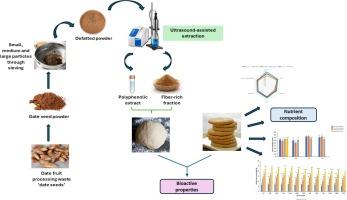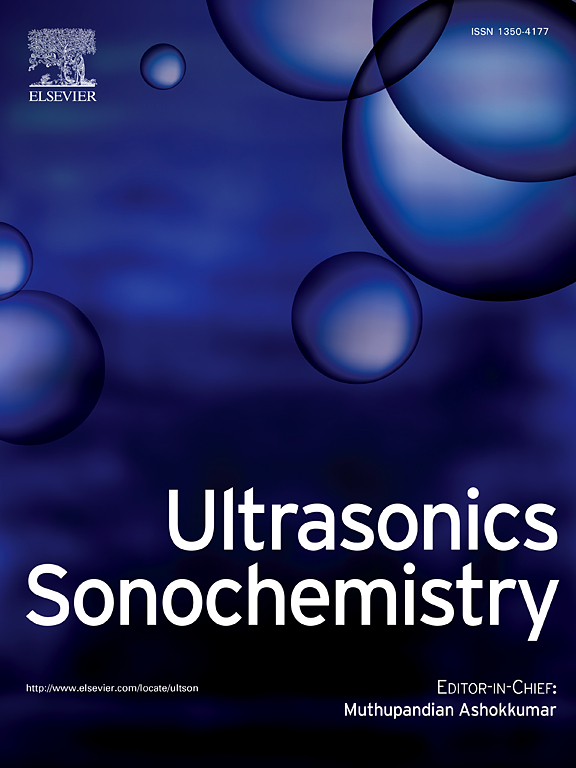Valorizing date seeds through ultrasonication to enhance quality attributes of dough and biscuit: Part 2 – Study on bioactive properties, sensory acceptance, in vitro gastrointestinal digestion and shelf life of biscuits
IF 8.7
1区 化学
Q1 ACOUSTICS
引用次数: 0
Abstract
Aligning with sustainable food system development, in this study, date seeds derived compounds were utilized as functional ingredient to formulate value-added biscuits. Ultrasound-assisted extraction (UAE) was employed as a non-thermal method to extract polyphenolic compounds from small, medium and large particles of defatted date seed powder (DDSP). The remaining fiber-rich fraction (residue) was further utilized. Water content in biscuit formulation was replaced by the extract, and the fiber-rich fraction was substituted at three substitution levels; 2.5 %, 5 % and 7.5 %. Effects of baking on bioactive properties of dough, nutrient composition, sensory analysis, bioaccessibility of polyphenols, and shelf-life of biscuits were analyzed. Total phenolic content (TPC) increased in dough and biscuit with incorporated fiber-rich fraction. TPC of dough decreased with increasing particle size of fiber-rich fraction while biscuits exhibited an opposite trend. Similar tendency was observed with antioxidant activity of dough and biscuit. TPC was higher in biscuits than dough, with the highest values of 0.46 mg gallic acid equivalents (GAE)/g and 2.26 mg GAE/g in dough and biscuit, respectively. Fiber and moisture contents in biscuits increased while protein content decreased with fortification. Consumers showed moderate acceptance of fortified biscuits with overall acceptability comparable with the control biscuits. Bioaccessibility index of polyphenols upon gastrointestinal digestion was high in biscuits with 5 % and 7.5 % substitution of small and medium sized particles of fiber-rich fraction. Phenolic retention increased with fiber fortification and at the end of 6 months the lowest thiobarbituric acid reactive substances (TBARS) value of 18.23 nmol malondialdehyde (MDA)/g sample, was observed in 7.5 % large particle substituted biscuit. Thus, utilizing date seeds in the form of green extracted polyphenols and fiber-rich fraction, as functional and bioactive ingredients highlight sustainable processing and utilization of date-fruit processing by-products which is in line with the circular economy approach.

超声强化枣籽提高面团和饼干品质的研究:第二部分——饼干的生物活性、感官接受度、体外胃肠消化和保质期研究
根据可持续食品系统的发展,本研究将枣籽衍生化合物作为功能成分,制备增值饼干。采用超声辅助提取法(UAE)从脱脂枣籽粉(DDSP)的小、中、大颗粒中提取多酚类化合物。剩余的富纤维馏分(残渣)进一步利用。用萃取物代替饼干配方中的水分,并在三个层次上代替富含纤维的部分;2.5%, 5%和7.5%。分析了烘焙对面团生物活性特性、营养成分、感官分析、多酚生物可及性和饼干保质期的影响。加入富纤维组分后,面团和饼干的总酚含量(TPC)增加。面团的TPC随富纤维组分粒度的增大而降低,饼干则相反。面团和饼干的抗氧化活性也有类似的趋势。饼干中的TPC高于面团,面团和饼干中的最高值分别为0.46 mg没食子酸当量(GAE)/g和2.26 mg GAE/g。随着强化,饼干中纤维和水分含量增加,蛋白质含量降低。消费者对强化饼干的接受程度中等,总体接受程度与对照饼干相当。饼干中多酚类物质经胃肠道消化的生物可及性指数较高,富含纤维的小颗粒和中颗粒替代率分别为5%和7.5%。在6个月时,7.5%大颗粒替代饼干的硫代巴比妥酸活性物质(TBARS)值最低,为18.23 nmol丙二醛(MDA)/g样品。因此,以绿色提取的多酚和富含纤维的成分的形式利用枣籽,作为功能性和生物活性成分,突出了枣果加工副产品的可持续加工和利用,符合循环经济的方式。
本文章由计算机程序翻译,如有差异,请以英文原文为准。
求助全文
约1分钟内获得全文
求助全文
来源期刊

Ultrasonics Sonochemistry
化学-化学综合
CiteScore
15.80
自引率
11.90%
发文量
361
审稿时长
59 days
期刊介绍:
Ultrasonics Sonochemistry stands as a premier international journal dedicated to the publication of high-quality research articles primarily focusing on chemical reactions and reactors induced by ultrasonic waves, known as sonochemistry. Beyond chemical reactions, the journal also welcomes contributions related to cavitation-induced events and processing, including sonoluminescence, and the transformation of materials on chemical, physical, and biological levels.
Since its inception in 1994, Ultrasonics Sonochemistry has consistently maintained a top ranking in the "Acoustics" category, reflecting its esteemed reputation in the field. The journal publishes exceptional papers covering various areas of ultrasonics and sonochemistry. Its contributions are highly regarded by both academia and industry stakeholders, demonstrating its relevance and impact in advancing research and innovation.
 求助内容:
求助内容: 应助结果提醒方式:
应助结果提醒方式:


